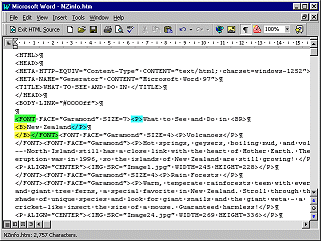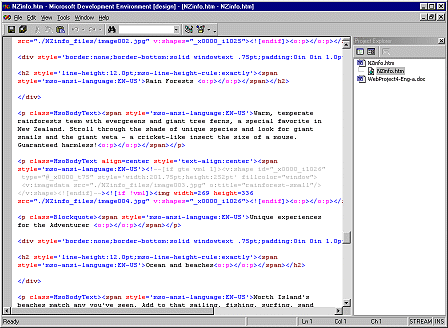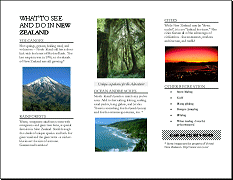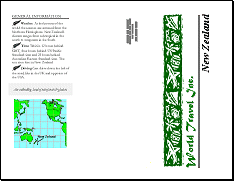Design Issues for Converted Documents
Web pages have different design issues than documents prepared for print.
The shape of the space is different. The physical interface is different.
The way people interact with web pages is different.
You may need to modify your converted document to make it more
web-friendly by:
- rearranging parts
- rewriting
- adding navigation
- breaking it into separate pages
Visual Field
A normal browser window shows much less text at once than a normal
printed page. You should place your illustrations so that they show in the
same window as the related text. It is harder for the reader to scroll
around than to flip back and forth between pages of a book.
How Readers Read
People scan web pages more than they read, especially
pages with lots of text or long paragraphs. This is partly because text
onscreen is not yet as comfortable to read as on paper. The characters are
not as crisp. Eyes get tired more easily.
Bullet lists and short paragraphs work best. (Some topics are not easy
to do in short form!)
Navigation
Unlike a printed page, each web page needs clear navigation to the top
of the site and to other pages in the site. A single table of
contents page won't do!
Clear Purpose
The visitor to your page may have popped in directly from a search
engine. Does the page make sense by itself? Can the visitor tell where
this page is in your site structure? Can the visitor navigate to an
overview page, to the home page, or to the beginning of the section?
Length
Breaking a long document into separate pages may work better than a
single long page. Readers don't like to scroll and scroll and scroll.
Neither do they like the long download time for a long page.
Each page should make sense by itself, so you may need to re-write or
add text after breaking into separate pages.
What to Use to Convert
You usually have at least two choices for converting a
document to a web page:
Original Program
Many programs, including Word and Excel, allow you to
save documents in HTML format. The resulting web page will probably need
some tweaking, however. Sometimes the changes that the conversion makes are
quite startling.
 Word 97: Conversion errors
Word 97: Conversion errors
-
Data in a Word textbox will not show up in the
HTML version.
-
Backgrounds - HTML background will be white.
White text therefore becomes invisible!
-
 Tags
incorrectly nested- In the illustration, some tags are
highlighted in color to show how Word97 often gets the closing tags in the
wrong order. Tags must be closed in the reverse order from how they were
opened. IE forgives this error and displays the page anyway. Other
browsers may not! Tags
incorrectly nested- In the illustration, some tags are
highlighted in color to show how Word97 often gets the closing tags in the
wrong order. Tags must be closed in the reverse order from how they were
opened. IE forgives this error and displays the page anyway. Other
browsers may not!
You must proof-read your converted document very
carefully to be sure that all of the parts arrived safely and in the
arrangement you want. You may need to edit the source code yourself to make
any corrections.
  Word 2000: When saving as a web page, Word 2000 uses a complex
internal stylesheet, so it can usually make the HTML page look almost
exactly like the Word document. But... it takes a lot of very messy code.
This makes the converted document MUCH longer and VERY hard to edit
yourself. In addition, the browser must understand stylesheets to make any
sense of the page at all.
Word 2000: When saving as a web page, Word 2000 uses a complex
internal stylesheet, so it can usually make the HTML page look almost
exactly like the Word document. But... it takes a lot of very messy code.
This makes the converted document MUCH longer and VERY hard to edit
yourself. In addition, the browser must understand stylesheets to make any
sense of the page at all.
 All Office 2000/2002
programs: If you use Save as Web Page from an Office 2000/02 program
(Word, Excel, etc), you should plan to use that program for all future edits
of this document. [Open the HTML page in the program, make changes,
and then re-save as a web page.] No one wants to deal with this source code
directly! All Office 2000/2002
programs: If you use Save as Web Page from an Office 2000/02 program
(Word, Excel, etc), you should plan to use that program for all future edits
of this document. [Open the HTML page in the program, make changes,
and then re-save as a web page.] No one wants to deal with this source code
directly!
 Microsoft
Office HTML Filter 2.0 Microsoft
Office HTML Filter 2.0 :
This filter allows you to export all or part of an Office document as
Compact HTML (removing all the extra code that Office adds). There are
advantages and disadvantages:
Use
Office HTML Filter to Create Web Pages that Download Faster :
This filter allows you to export all or part of an Office document as
Compact HTML (removing all the extra code that Office adds). There are
advantages and disadvantages:
Use
Office HTML Filter to Create Web Pages that Download Faster . .
HTML Editing Software
Some HTML editors can open a variety of other file types
directly. They generally can only save as a web page. You will have to
experiment to see whether you get the best results with the original program
or with your editing software.
 FPX,
unfortunately, cannot actually open much besides HTML files and text files.
The Open dialog actually lists file types that FPX cannot actually open! FPX,
unfortunately, cannot actually open much besides HTML files and text files.
The Open dialog actually lists file types that FPX cannot actually open!
Problem: Complex Documents
Saving a complex document as HTML may not produce a useable document.
Example: The original tri-fold brochure, adapted for the
Step-by-Step on the next page, used textboxes to create three columns. A
direct Save As using the file type HTML will include only the blank mailing
address section and the front flap, at the far right below. Totally useless
on the Web!
 
Inside and outside of the original
tri-fold brochure as a Word document
 Word 97:
Saving the original brochure as HTML with Word 97 results in a
blank document! Word 97 ignores what's in textboxes. Word 97:
Saving the original brochure as HTML with Word 97 results in a
blank document! Word 97 ignores what's in textboxes.
 Word
2000/02: The new Save as Web Page command in Word 2000/02 does
a better job, but adds tons of hidden code to do it. The new document will
be a mess in browsers that don't understand stylesheets. Even with all
this, the vertical green decorative bar at the far right above comes out
aligned above all the other objects. Word
2000/02: The new Save as Web Page command in Word 2000/02 does
a better job, but adds tons of hidden code to do it. The new document will
be a mess in browsers that don't understand stylesheets. Even with all
this, the vertical green decorative bar at the far right above comes out
aligned above all the other objects.
To save as a web page without all the extra code for Word editing, use
the command |
and set the File Type to Web page, filtered. You
will get a much smaller file with only the formatting that can be done
with regular HTML, instead of stylesheet formatting.
 Working with complex
documents: *****Simplify first! *****Copy the contents and
paste to a new, simpler document. Convert this new document to HTML. It may
take several steps, depending on how complex your document is. It's awkward
but more workable in the long run. Working with complex
documents: *****Simplify first! *****Copy the contents and
paste to a new, simpler document. Convert this new document to HTML. It may
take several steps, depending on how complex your document is. It's awkward
but more workable in the long run.
|

![]()
![]()